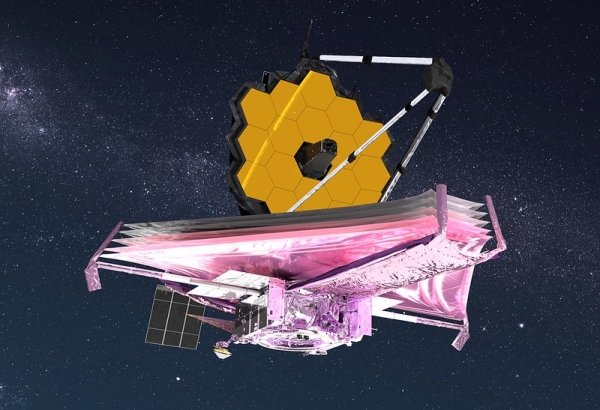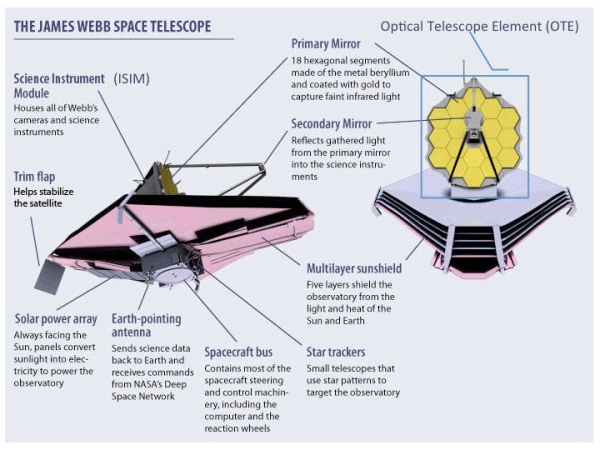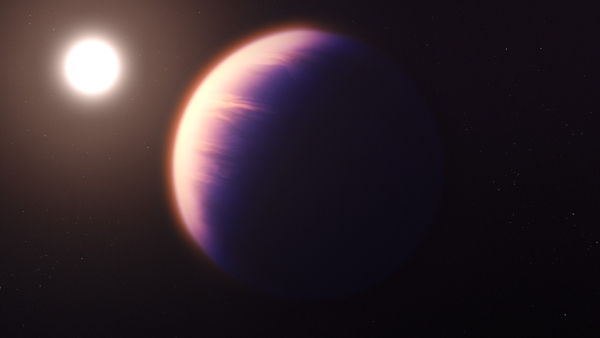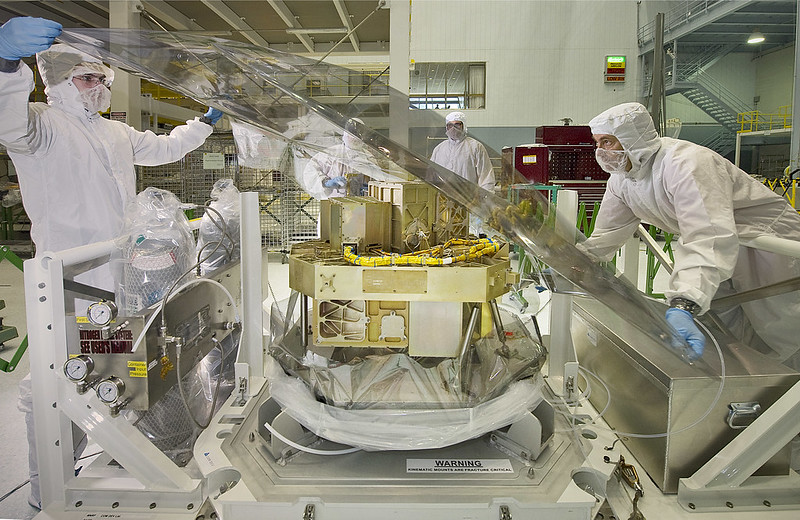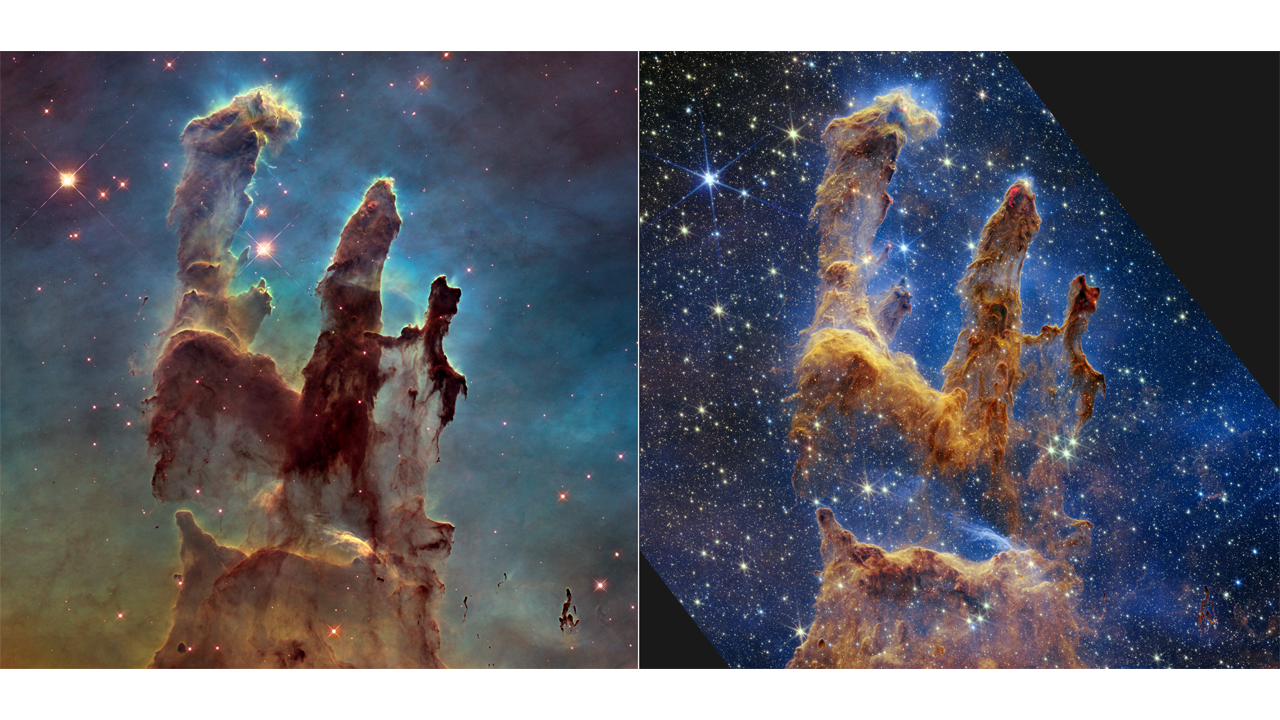Seeing the Universe with the James Webb Telescope
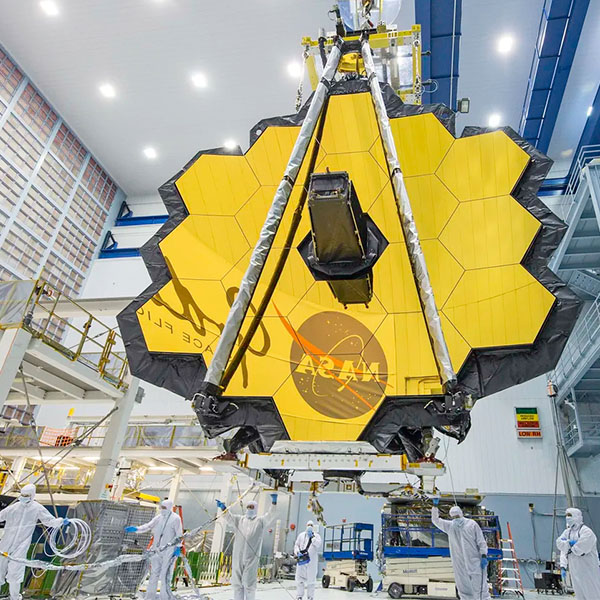
Telescope under construction (NASA/Desiree Stover)

Telescope under construction (NASA/Desiree Stover)
How does this align with my curriculum?
Learn about the James Webb telescope and Canada’s role in the mission.
Many people say that astronomy is the oldest science. Humans have been observing the stars and planets in the sky for thousands of years using only their eyes!
Over time, astronomers have invented tools to understand the Universe. The tool astronomers are best known for is, of course, the telescope! How have modern telescopes changed the way we look at space?
Image - Text Version
Shown is a colour photograph of four large spherical silver structures.
The photograph is panoramic, showing a very wide, flat landscape. Three of the structures are in a row on the left side. The last structure is just to the right of the row, in the distance. All the structures are spherical, but flat on one side, where a dark coloured vent can be seen. The rounded sides have three rows of dark squares, set into the silver siding. The base of each structure is round with a series of thick grey columns. Extending out from the base are what look like railway tracks. Large octagon shapes are set into the ground between them, at regular intervals.
Different Types of Light, Different Telescopes
Scientists often put telescopes in remote locations like mountain tops or dry deserts. When choosing a spot for a telescope, you want to pick somewhere very dark, very dry, and very high up. This makes for the best observations of objects like stars and galaxies.
When looking at objects in space, astronomers mainly look at a type of light called visible light. This is the same type of light humans can see with their eyes. But did you know that there are many types of invisible light? Invisible light includes x-rays, infrared light, and even radio waves. Humans cannot see these kinds of light with their eyes alone. That does not mean that objects in space do not shine with those types of light. This is why astronomers build special telescopes to be able to see these kinds of light.
The James Webb Space Telescope
Scientists and engineers from all over the world built the James Webb Space Telescope. This telescope looks at infrared light. Astronomers need to look at infrared light to study certain types of objects.
These include planets inside and outside our Solar System and very distant galaxies. Infrared light can also shine through all the cosmic dust found in space. This dust blocks out most of the visible light from stars. Using Webb’s infrared eye, astronomers can see the Universe like never before!
Image - Text Version
Shown is a colour illustration of a complex object with a large gold mirror, floating in space.
The mirror is at the top of the object. It is a concave hexagon, made of smaller hexagon-shaped, gold. mirrored tiles. The centre tile is missing, where a long, black structure extends forward. Long white poles are attached to three corners of the mirror. They meet at a point in front of the mirror, in front of the long black structure.
The lower part of the object is a stack of four triangles, made from soft fabric or plastic. These are held in place by a large T-shapes bracket at the bottom. At the junction of the T is a cube with a circle on the bottom, covered in silver foil. A small square flap can be seen behind the triangles. Pink light shines on this part of the object.
There is one huge challenge to overcome when building an infrared telescope. The Earth’s atmosphere actually blocks infrared light. This means that an infrared telescope on Earth would not work very well. An infrared telescope, like the Webb Telescope, works best when it is in space!
Image - Text Version
Shown is a colour diagram of a space telescope, with its parts labelled.
The title, "James Webb Space Telescope," is underlined in the top left corner. The object in this diagram is very similar to the one in the illustration above.
On the left, the telescope is shown from the bottom. The pink, triangular section is in full view, and the gold mirror section is just visible above.
A conical section just behind the mirror is labelled, "Science Instrument Module (ISIM),: Houses all of Webb's cameras and science instruments."
The flap on the left side is labelled, "Trim flap: Helps stabilize the telescope."
A long, grey panel on the bottom of the triangles is labelled, "Solar power array: Always facing the sun, panels convert sunlight into electricity to power the observatory."
A small, square object at the end of the panel is labelled, "Earth-pointing antenna: Sends science data back to Earth and receives commands from NASA's Deep Space Network."
The cube-shaped structure at the centre of the bracket is labelled, "Spacecraft bus: Contains most of the spacecraft steering and control machinery, including the computer and the reaction wheels."
A dark area beside the cube is labelled, "Star trackers: Small telescopes that use star patterns to target the observatory."
The stacked, pink triangles are labelled, "Multilayer sunshield: Five layers shield the observatory from the light and heat of the sun and Earth."
On the right, the top of the telescope is shown. The gold mirror structure is in full view. This area is labelled, "Optical Telescope Element (OTE)."
The gold, tiled area is labelled, "Primary mirror: 18 hexagonal segments made of metal beryllium and coated with gold to capture faint infrared light."
A small, circular piece where three poles meet, in front of the centre of the mirror, is labelled, "Secondary mirror: Reflects gathered light from the primary mirror into the science instruments."
After many years of hard work, the Webb telescope was launched on December 25, 2021. It flew to its final destination, about 1.5 million kilometres from Earth. That is four times farther away than the Moon!
During the first half of 2022, scientists made the telescope unfold. They turned on all its instruments, and made sure all its parts were working well.
Canada’s Role
Canadian scientists are taking part in this exciting mission. Canada has contributed a scientific instrument and a guiding camera.
There are four scientific instruments aboard the Webb Telescope. Canada contributed the NIRISS instrument. This instrument can both take pictures and study the broken-down light of objects.
Image - Text Version
Shown is a colour illustration of a planet, with a star in the distance.
A crescent-shaped portion of the planet is lit by its star. It appears purple swirled with white. Its surface is blurred, as if foggy, and is illuminated in pale gold.
In the distance, to the left of the planet, its star glows bright white. The space around is black with tiny pinpricks of stars.
In addition to the NIRISS instrument, Canada also provided a guiding camera for the telescope. This camera acts like the telescope’s eye so it can find and lock on to its targets. Since Canada contributed these tools, Canadian astronomers are some of the first to use the telescope!
Image - Text Version
Shown is a colour photograph of two people stretching clear plastic over an intricate, gold-coloured machine.
Four people are gathered around the machine, in a large, white room. They are all wearing white, hooded coveralls, masks, and blue gloves. The machine appears to sit on a turntable. It is made of a series of cubes, boxes, and a hexagon, joined together. All the parts are the same pale gold metal.
In the foreground, two people are stretching a large piece of clear, flexible plastic over the machine. Two more people watch from the background.
The best is yet to come!
In the first few weeks and months since it started working, Webb has already taken incredible images of the cosmos. You may have already seen some of them yourself!
Image - Text Version
Shown are two colour photographs of the same three-pronged gas formation.
The gas forms three long, thin pillars, joined at the base, surrounded by deep blue space, dotted with stars.
In the left image, the pillars are dark brown, and appear like shadows against the stars. They have a lumpy, organic texture. The space around is cloudy with pale blue and gold gases. A few bright gold stars shine through.
In the right image, the pillars are more clearly defined. They appear rough, like stone, in shades of brown and gold. The space around is also much brighter. It is not cloudy, but dense with bright stars, and washes of paler blue.
When comparing these images to those taken by other telescopes, it is easy to see why Webb is showing us a brand-new point of view of space. And this incredible mission should continue to observe the infrared Universe for years to come. You might even be one of the astronomers using Webb’s observations one day!
Let’s Talk Science would like to acknowledge the contributions of Nathalie Ouellette in the development of this backgrounder.
Nathalie Ouellette
The James Webb Space Telescope is the most complex and powerful space telescope ever built. Canada has contributed a scientific instrument and a guidance sensor. Canadian scientists are taking part in its exciting science mission that promises to change our understanding of the universe. Webb is an international collaboration between NASA, the European Space Agency, and the Canadian Space Agency.
Learn More
The Canadian Space Agency’s website for the Webb Telescope
Find out more about Canada’s contribution to the mission and what Canadian astronomers will be studying with the Webb Telescope.
The Space Telescope Science Institute’s website for the Webb Telescope
See all of the amazing images taken by the Webb Telescope and learn about the science behind these images.
NASA’s website for the Webb Telescope
Find out more about the mission in general from the collaboration’s lead agency.
References
Adkins, J. (Dec 1, 2022). James Webb Space Telescope. NASA.
Goddard Space Flight Center (n.d.). James Webb Space Telescope. NASA.
Space Telescope Science Institute (n.d.). Webb Space Telescope.

